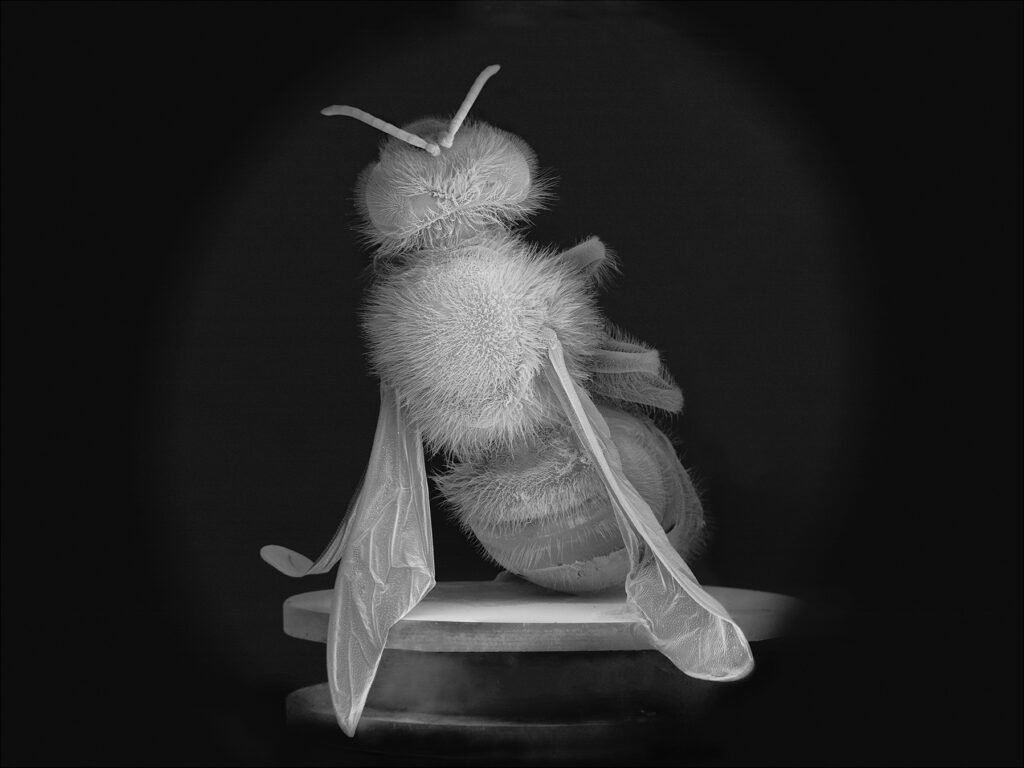
Anne Noble, The Dead Bee Portraits #2. Courtesy of the artist.
For our series Making of a Poem, we’re asking poets to dissect the poems they’ve published in our pages. Eliot Weinberger’s “The Ceaseless Murmuring of Innumerable Bees” appears in our new Spring issue, no. 247.
How did this poem start for you? Was it with an image, an idea, a phrase, or something else?
First, I doubt it qualifies as a poem. It starts out as a simulacrum of a poem and then turns into an essay—or at least what I consider to be an essay, which is sometimes mistaken for a poem or a prose poem.
Its origin was a letter I received out of the blue from a photographer in Aotearoa/New Zealand, Anne Noble, whose work includes portraits of dead bees, some done with such devices as electron microscopes and 3D printers. She knew my collaboration with the Maori painter Shane Cotton (the essay “The Ghosts of Birds”) and asked me to write a text for a catalog of her photographs she was preparing.
At the time I wasn’t able to help, but a few years later—long after the catalog had been published—I found it was finally the moment to get to the bees.
Were you thinking of any other poems or works of art while you wrote it?
I spent a long time with bee-related writings and artworks, but wasn’t particularly thinking then of works that had no bees. However, my permanent models for an unadorned narrative are the Icelandic sagas and classical Chinese works called anomaly accounts (zhiguai), and my models for the condensation of large amounts of historical information are Charles Reznikoff and, in certain poems, Lorine Niedecker.
How did you come up with the title for this essay?
It comes from a line of Tennyson (“And murmuring of innumerable bees”) that is frequently given as the perfect example of onomatopoeia. (Though it’s an old joke that the same effect could be achieved with “and murdering of innumerable beeves.”) I added “ceaseless,” as there are a lot of bees from all ages flying through the lines in an incessant drone.
How did writing the first draft feel to you? Did it come easily, or was it difficult to write? How about the second draft? The third? How many drafts were there and what were the primary differences between them?
I have a strange way of writing. Most writers tend to write a great deal and then cut much of it out. I start with a few lines or a paragraph, not necessarily the beginning, and keep adding to the middle, beginning, or end. I very rarely delete a whole line or sentence, though I’m continually replacing words in them. Everything goes through many drafts, and the essay grows organically, like a crystal, even if the result is not especially crystalline.
When did you know this piece was finished? Were you right about that? Is it finished, after all?
There comes a moment when the writing achieves a state of rest and just sits there like a rock. Then you move on to the next thing.
I’ve never rewritten old things, but I have expanded them. My whole book Angels & Saints is an expansion of a one-paragraph essay I had written twenty years before—but I didn’t change the original paragraph.
Did you show your drafts to other writers or friends or confidants? If so, what did they say?
I’ve never shown an unfinished manuscript to anyone, and the finished ones generally go directly to the editor or publisher involved. And then I very rarely allow any editorial changes, except for the correction of genuine mistakes. You might say I have an authority problem, but I’m the author.
What was the challenge of this particular piece?
I tend to write about things I know nothing about, and there is of course a vast amount published on any given topic. Eventually I have to abandon further research, accept my ignorance, and start writing. After all, I’m trying to create a literary text, not produce an academic article.
In this case, early on I decided to avoid two enormous subjects connected to bees—honey and their current worldwide extermination. Since the poem/essay is largely about bees and death, war, politics, and religion, I thought the huge world around honey would be a distraction. And with death hanging over it, there was no need to get into the specifics of the present disaster, which is implicit.
For me, writing is not a “challenge,” in the sense of some sort of guy mano a mano with inner demons, ancestral masters, silence, or the blank page. There are people who just like their job.
Eliot Weinberger’s most recent books are Angels & Saints and The Life of Tu Fu, both published by New Directions.
from The Paris Review https://ift.tt/5Pq4aKB
Comments
Post a Comment